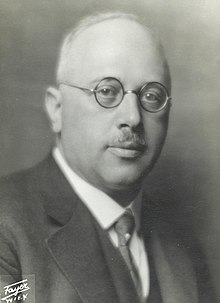Felix Ehrenhaft | |
|---|---|
 Felix Ehrenhaft | |
| Born | 24 April 1879 |
| Died | 4 March 1952 (aged 72) |
| Nationality | Austrian |
| Alma mater | University of Vienna (PhD, 1903) |
| Spouse | Olga Ehrenhaft-Steindler |
| Awards | Lieben Prize 1910 Haitinger Prize 1917 |
| Scientific career | |
| Fields | Theoretical physics |
| Institutions | University of Vienna |
| Doctoral advisor | Franz-Serafin Exner |
| Doctoral students | Georg Stetter Walter Thirring |
Felix Ehrenhaft (24 April 1879 – 4 March 1952) was an Austrian physicist who contributed to atomic physics, to the measurement of electrical charges and to the optical properties of metal colloids. He was known for his maverick and controversial style. His iconoclasm was greatly admired by philosopher Paul Feyerabend. He won the Haitinger Prize of the Austrian Academy of Sciences in 1917.[1]
Ehrenhaft was born in Vienna to physician Leopold Ehrenhaft and Louise Eggar, the daughter of a Hungarian industrialist. Ehrenhaft earned his doctorate from the University of Vienna in 1903, working on the optical properties of metallic colloids. He subsequently became assistant to Franz S. Exner.
In 1907, the reality of atoms was still disputed but Albert Einstein and Marian Smoluchowski had both recently given accounts of Brownian motion in liquids, strongly supporting the atomic theory. Though Theodor Svedberg had made important demonstrations of Brownian motion in colloids, Ehrenhaft extended the work to make observations of particles of silver in air. The greater mean free path of air made for a sterner test of the reality of atoms. Ehrenhaft was awarded the Lieben Prize of the Vienna Academy of Sciences for his work.
In 1908, he married physicist Olga Steindler.[2] They had two children, Johannes Leopold Friedrich, born on 10 October 1915, and Anna Maria Luise, born 19 February 1917. Both emigrated to the United States in the 1930s.[3]
Ehrenhaft adapted his apparatus to measure the elementary charge and subsequently became involved in a bitter controversy with Robert Millikan, claiming to have measured an electric charge less than that of a single electron, Millikan being passed over for the 1920 Nobel Prize in physics owing to the unresolved nature of the debate. Controversy eventually subsided as more and more physicists were swayed by Millikan's results but even as late as 1940, Albert Einstein wrote:
Concerning his results about the elementary charge I do not believe in his [Ehrenhaft's] numerical results, but I believe that nobody has a clear idea about the causes producing the apparent sub-electronic charges he found in careful investigations.
Even while controversy raged on sub-electronic charges, Ehrenhaft made important and substantial contributions to physics including the demonstration of photophoresis and other effects on the interaction of particles with light. Some of these effects have subsequently been explained in terms of existing phenomena, but some still remain poorly understood. He became professor of experimental physics at Vienna in 1920 and was known as a conscientious researcher and effective lecturer though single-minded to the point of absurdity. Albert Einstein was a frequent visitor to his home. Following the Anschluss in 1938, Ehrenhaft emigrated, first to England, then to the U.S. where he became a citizen.
From the mid-1930s, Ehrenhaft's thinking started to diverge strikingly from the mainstream of physics. He observed many genuinely surprising and reproducible physical phenomena, usually of ultra-microscopic particles near the limits of perception. However, he was all too willing to adopt alternate theories to explain experiments that were beset with interactions and multifactorial cause systems.
From the 1940s, Ehrenhaft's views became increasingly extreme and strident, eventually terminating his good friendship with Albert Einstein. He found it impossible to obtain either research funding or even a sympathetic hearing in the U.S. In 1946, he returned to the University of Vienna where he held again his old position until his death. He became increasingly certain that he had observed magnetic monopoles, magnetic currents and magnetolysis, the disassociation of liquids by magnets rather than electric current as in electrolysis.
A review of his life work can be found in the Austrian scientific journal "Acta physica Austriaca", and in the article by Rohatschek on photophoresis (see sources below).